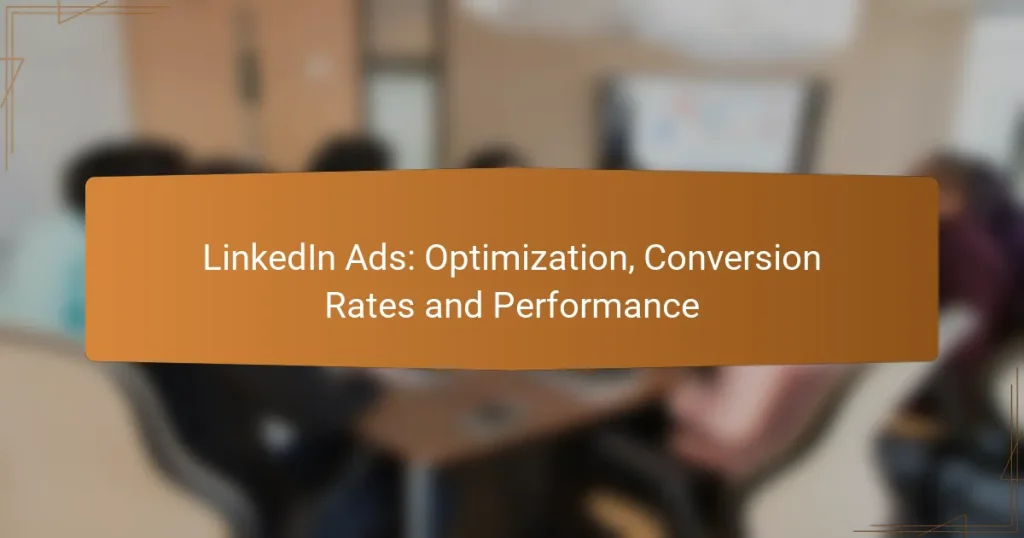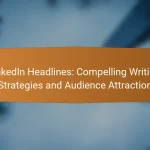Optimizing LinkedIn Ads is crucial for enhancing campaign performance and boosting conversion rates. By implementing targeted strategies such as precise audience segmentation, selecting appropriate ad formats, and continuously analyzing performance metrics, advertisers can significantly improve engagement. Additionally, creating compelling content and optimizing landing pages further drive conversions, making it essential to measure and adjust campaigns based on key performance indicators.

How to optimize LinkedIn Ads for better performance?
To optimize LinkedIn Ads for better performance, focus on precise targeting, selecting the right ad formats, adjusting bid strategies, testing creative elements, and analyzing performance metrics. These strategies help enhance engagement and conversion rates, leading to a more effective advertising campaign.
Target audience segmentation
Effective audience segmentation is crucial for LinkedIn Ads optimization. By defining specific demographics, job titles, industries, and interests, you can tailor your ads to resonate with the right users. Utilize LinkedIn’s audience targeting tools to create segments that align with your campaign goals.
Consider creating multiple audience segments to test which performs best. For example, you might target marketing professionals in tech versus those in finance to see which group engages more with your content.
Ad format selection
Selecting the appropriate ad format can significantly impact your campaign’s success. LinkedIn offers various formats, including sponsored content, message ads, and dynamic ads, each serving different objectives. Choose a format that aligns with your goals, whether it’s brand awareness, lead generation, or direct engagement.
For instance, sponsored content is effective for storytelling and engagement, while message ads can drive direct responses. Experiment with different formats to determine which yields the best results for your target audience.
Bid strategy adjustments
Adjusting your bid strategy is essential for maximizing your ad spend efficiency. LinkedIn provides options like cost-per-click (CPC) or cost-per-impression (CPM), allowing you to choose based on your campaign objectives. Monitor performance and adjust bids accordingly to ensure you remain competitive in your target market.
Consider starting with automated bidding to gauge initial performance, then refine your strategy based on data insights. Setting a daily budget can help manage costs while testing different bid strategies.
Creative testing
Creative testing involves experimenting with various ad designs, copy, and calls-to-action to identify what resonates best with your audience. A/B testing can reveal which elements drive higher engagement and conversion rates. Make small adjustments to visuals or messaging to see what impacts performance.
For example, try different headlines or images in your ads to find the most effective combination. Regularly refresh your creative to avoid ad fatigue among your audience.
Performance analytics
Analyzing performance metrics is vital for understanding the effectiveness of your LinkedIn Ads. Utilize LinkedIn’s analytics tools to track key performance indicators (KPIs) such as click-through rates, conversion rates, and engagement levels. Regularly reviewing these metrics helps identify trends and areas for improvement.
Set benchmarks based on industry standards and your previous campaigns to measure success. Use insights gained from analytics to refine your targeting, creative, and bidding strategies for ongoing optimization.

What are the best practices for improving conversion rates on LinkedIn Ads?
To enhance conversion rates on LinkedIn Ads, focus on creating compelling content, optimizing landing pages, and utilizing LinkedIn’s Lead Gen Forms. These strategies can significantly increase user engagement and drive more conversions from your advertising efforts.
Compelling call-to-action
A strong call-to-action (CTA) is crucial for driving conversions on LinkedIn Ads. Use clear, action-oriented language that tells users exactly what to do, such as “Download Now” or “Get Started Today.” Position your CTA prominently within your ad to ensure it stands out.
Consider testing different CTAs to see which resonates best with your audience. A/B testing can help identify the most effective wording and placement, which can lead to higher engagement rates and improved conversions.
Landing page optimization
Optimizing your landing page is essential for converting clicks into actions. Ensure that the landing page aligns with the ad’s message and provides a seamless user experience. Fast loading times and mobile responsiveness are critical factors that can influence user retention.
Include relevant content, such as testimonials or case studies, to build trust and credibility. A clean design with a clear path to conversion can significantly enhance the likelihood of users completing the desired action.
Utilizing LinkedIn Lead Gen Forms
LinkedIn Lead Gen Forms streamline the process of capturing leads directly within the platform. These forms auto-fill user information, making it easier for potential customers to submit their details without leaving LinkedIn. This convenience can lead to higher conversion rates.
To maximize effectiveness, customize your Lead Gen Forms with relevant questions that help qualify leads. Keep the form concise to avoid overwhelming users, and ensure that you clearly communicate the value of submitting their information, such as access to exclusive content or offers.

How to measure LinkedIn Ads performance effectively?
Measuring LinkedIn Ads performance involves tracking key metrics that indicate how well your campaigns are achieving their goals. By focusing on specific performance indicators and utilizing tools for conversion tracking, you can gain insights into your ad effectiveness and optimize accordingly.
Key performance indicators (KPIs)
Key performance indicators (KPIs) for LinkedIn Ads include metrics such as click-through rate (CTR), conversion rate, cost per click (CPC), and return on ad spend (ROAS). These metrics help assess the effectiveness of your ads in driving traffic and conversions.
For example, a CTR of 0.5% to 1% is generally considered average for LinkedIn Ads, while a conversion rate of 2% to 5% can indicate a successful campaign. Regularly monitoring these KPIs allows for timely adjustments to improve performance.
Conversion tracking setup
Setting up conversion tracking on LinkedIn is essential for measuring the success of your ads. This involves adding the LinkedIn Insight Tag to your website, which tracks user actions such as form submissions or purchases after clicking on your ads.
To ensure accurate tracking, verify that the Insight Tag is correctly installed and functioning. You can test it using LinkedIn’s Tag Helper tool. Proper setup enables you to attribute conversions directly to your LinkedIn campaigns, providing valuable data for optimization.
Campaign performance reports
LinkedIn provides detailed campaign performance reports that summarize your ads’ effectiveness over time. These reports include insights on impressions, clicks, conversions, and overall spend, allowing you to evaluate your return on investment.
Regularly reviewing these reports can help identify trends and areas for improvement. For instance, if a particular ad set shows a high CPC but low conversion rate, it may need adjustments in targeting or creative elements to enhance performance.

What are the common challenges in LinkedIn Ads management?
Managing LinkedIn Ads presents several challenges that can hinder campaign success. Key issues include budget constraints, ad fatigue, and difficulties with audience targeting, all of which require careful consideration and strategic planning.
Budget constraints
Budget constraints are a significant challenge in LinkedIn Ads management, as costs can quickly escalate. Advertisers often face high cost-per-click (CPC) rates, which can limit the number of clicks and impressions within a given budget.
To manage budgets effectively, set clear goals and allocate funds based on expected return on investment (ROI). Regularly monitor spending and adjust bids to stay within budget while maximizing ad exposure.
Ad fatigue
Ad fatigue occurs when the same audience sees the same ads repeatedly, leading to decreased engagement and performance. This is common on platforms like LinkedIn, where users may become desensitized to familiar ads.
To combat ad fatigue, rotate creatives frequently and test different formats. Consider using A/B testing to determine which ads resonate best with your audience and refresh your content regularly to maintain interest.
Audience targeting issues
Effective audience targeting is crucial for LinkedIn Ads success, but misalignment can lead to wasted spend and poor conversion rates. Advertisers may struggle to define their target audience accurately, resulting in ads reaching the wrong individuals.
Utilize LinkedIn’s robust targeting options, such as job title, industry, and company size, to refine your audience. Regularly review and adjust targeting parameters based on campaign performance to ensure ads reach the most relevant users.

What tools can assist in LinkedIn Ads optimization?
Several tools can enhance LinkedIn Ads optimization by providing insights, analytics, and automation features. Utilizing these tools can help marketers improve ad performance, increase conversion rates, and achieve better ROI.
LinkedIn Campaign Manager
LinkedIn Campaign Manager is the primary platform for managing ads on LinkedIn. It provides detailed analytics on ad performance, allowing users to track metrics such as click-through rates, impressions, and conversions. By analyzing this data, advertisers can make informed adjustments to their campaigns to optimize results.
Utilizing A/B testing features within Campaign Manager can help determine which ad creatives or targeting options perform best. Regularly reviewing performance metrics is crucial for ongoing optimization.
Google Analytics
Google Analytics can be integrated with LinkedIn Ads to track user behavior on your website after they click on your ads. This tool allows you to analyze traffic sources, user engagement, and conversion rates, providing a comprehensive view of how LinkedIn traffic performs compared to other channels.
By setting up goals and conversion tracking in Google Analytics, you can measure the effectiveness of your LinkedIn Ads in driving desired actions, such as form submissions or product purchases. This data can guide further optimization efforts.
AdEspresso
AdEspresso is a user-friendly tool that simplifies the management and optimization of LinkedIn Ads. It offers features like A/B testing, performance analytics, and ad creation assistance. This platform is particularly beneficial for small to medium-sized businesses looking to streamline their ad processes.
With AdEspresso, you can easily compare different ad variations and identify which ones yield the highest engagement and conversion rates. Its intuitive dashboard makes it accessible for marketers at all experience levels.
HubSpot
HubSpot provides a comprehensive marketing platform that includes tools for managing LinkedIn Ads. Its integration allows for seamless tracking of leads generated from LinkedIn campaigns, enabling marketers to assess the overall effectiveness of their ads.
Using HubSpot’s analytics, you can gain insights into how LinkedIn Ads contribute to your sales funnel. This information helps in refining targeting strategies and improving ad content to better resonate with your audience.


